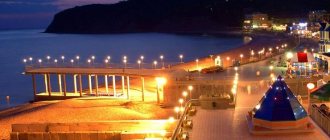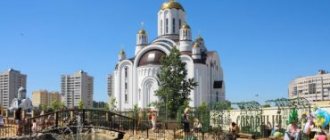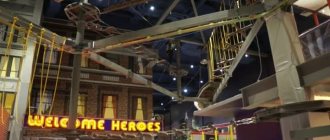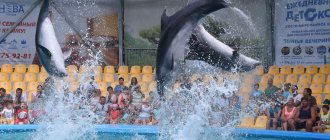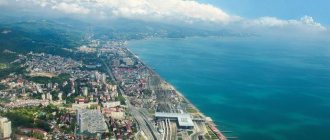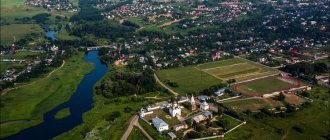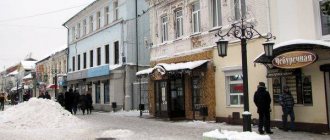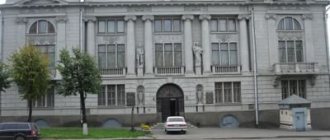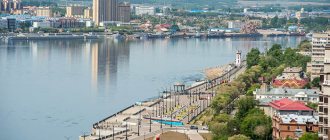I visited Smolensk for the first time in September several years ago as part of a four-day tour. But of these four days, only one was allotted to Smolensk itself, so we looked at the city at a waltz pace, covering only the main attractions. But I felt that there was some unsaidness between me and this city, so I decided to go to Smolensk on my own. Fortunately, I found good company in the person of a friend who was ready for anything except a hunger strike; a date was chosen and train tickets were purchased. While we were on the train, I told my friend about how I visited Smolensk for the first time.
Smolensk
Smolensk
First acquaintance with Smolensk
We spent one of the days of the excursion tour in Smolensk. The walking tour of the historical city center was wonderful, and the presence of a bus made it possible to smooth out all the inconveniences of moving around this very center, and even include three museums in the program. The tour was intense and, despite the fact that we spent the night in the city and had free time after dinner, we did not have the energy to explore the local attractions on our own. In addition, the weather pleased us with only one sunny day, or rather, half a day, and this wonderful time fell on a trip to Novospasskoye. So I remember Smolensk itself as gray and rainy. Add to this the presence of not the best photographic equipment and you will understand that it was necessary to return to this city. However, since spending the night in a Smolensk hotel did not leave a very good feeling, and our guide said that there were only two hotels in the city and the second one was much worse than the one we stayed in, the plan for a repeat tour remained in the plans. Once, on the website of a well-known tour operator, I did not see an offer for a one-day excursion trip to Smolensk. The excursion did not suit me due to the overloaded program, but the idea of a one-day trip to this city settled in my head. To be honest, I wanted to go there in the summer, but while I was looking for company, time, money... In general, everything came together again in the fall. At the end of October. And again I didn’t see the sunny city.
Smolensk
Smolensk
Trip to Flenovo
We were moving towards Flenov, the place we had been dreaming of getting to for many years.
Before your trip, I recommend reading the memoirs of Princess Tenisheva, when you are in the right mood. We read them after the trip, which wasn't bad either. The guide talked about Tenisheva, more about her biography. In my opinion, the biography is important and interesting, but what is more interesting is what she did culturally, educationally, and agriculturally. Tenisheva acquired Flenovo in 1894. The princess dreamed of creating an agricultural school on the estate, unlike the educational institutions of that time. The following year the school opened its doors to students. The princess personally selected the students. They could be the children of peasants and low-income citizens. Orphans were educated fully. The school building housed classrooms, a dining room, a dormitory and a kitchen. I had to study for 6 years. The emphasis was on subjects related to agriculture: agriculture, zoology, horticulture, etc.
Tenisheva set herself a noble goal. She wanted not only to teach the children, but also to raise honest people and discover their talents. They tried their best to teach even weak students the craft. The princess sent talented children to study at her own expense.
The school ceased to exist after the revolution. The church built on the site was looted and turned into a vegetable storehouse, the prince’s grave was desecrated. Few buildings of the Flenovo estate have survived to this day. Looking at the House-Teremok, you will probably think that it came out of a Russian folk tale. Pay attention to the traditional carvings decorating the Teremok.
The museum inside is full of masterpieces of Russian applied art.
Our story about Teremka can be read here
To the right of the House on the hill rises the Church of the Holy Spirit. The unusual shape of the temple and its decor have no analogues. Nicholas Roerich had a hand in the gate mosaic. In memory of the prince, a cross was erected in the church yard. The Temple itself was created as a tomb for Tenishev.
On the territory we visited two museums: a rural school and a teremok. At the school, a classroom was reproduced and an exhibition was made telling about what crafts the children were taught.
The day in Smolensk did not end there; after a comprehensive lunch, our group went on a walking tour, the main topic of which was the military past of the city, we remember that Smolensk is a city of military glory.
Every corner of the city preserves the memory of the feat, even recreation parks are imbued with this theme. Along with entertainment and modern art objects, we see monuments, steles...
It is convenient to travel from Moscow to Smolensk by train “Lastochka”
“Lastochka” departs from the Belorussky railway station at 7.10 am and makes five stops along the way from Moscow to Smolensk. A small digression: seeing how many people were coming out in Gagarin, my companion and I went online to look for what was interesting in this city, but we didn’t see anything unusual. Later, one woman at work explained that many people have dachas in this direction, and direct trains were cancelled. And now summer residents also travel on Swallows. What I mean is that tickets must be purchased in advance not only because of the increasing price, but also because there may not be seats on the train. We bought tickets about a week and a half before the trip. A separate review needs to be written about “Swallows”, as well as about Moscow train stations. But I don’t want to grumble, because it’s still good that they exist: fast, clean, serviceable. I’ll just say that we had a problem buying coffee and pies, because the conductors don’t accept cards and they don’t have small money for change. First impression of Smolensk: station and church of the pre-Mongol period We arrived in Smolensk at 11.26. The station building made a pleasant impression: freshly painted, clean, and neat. And the platforms look well maintained.
Smolensky station
Smolensky station
But the same cannot be said about the station area. There, like everywhere else: tipsy people, offers of taxis, buses meeting tourists. Among all this, literally “sandwiched” are the Peter and Paul Church on Gorodyanka and the Temple in honor of the Holy Great Martyr Barbara.
Peter and Paul Church on Gorodyanka and the Temple in honor of the Holy Great Martyr Barbara
Peter and Paul Church on Gorodyanka and the Temple in honor of the Holy Great Martyr Barbara
By the way, the Peter and Paul Church was built in the 12th century and is a monument of pre-Mongol architecture. True, unfortunately, it was rebuilt several times. And it was even a church in the 17th century, when Smolensk belonged to the Poles. In general, I never make a walking route. I prefer to act under the motto: “Walk. I saw it. She exclaimed. I ran to look." So this time, I simply outlined the objects that I definitely wanted to see, what made a strong impression in 2012, and this is the iconostasis of the Assumption Cathedral, the model of the Smolensk fortress and the “Russian Court” cafe, where we were fed lunch. The only thing is that I looked at the map on the route from the station to the Assumption Cathedral, since the station was not included in the city tour and I had absolutely no idea where it was, but from the cathedral you can already get your bearings, remember the route of your last trip and find other objects without a map. So I decided and assured my companion of this.
Monument to the Heroes of 1812
The best monument in Smolensk, in my opinion, is the Monument to the Heroes of 1812. Monument with eagles, as the Smolensk people call it. The foundation stone for this monument was laid on August 6, 1912, on the centenary of the war with Napoleon.
The grand opening took place on September 10, 1913. The monument was erected according to the design of sculptor S. R. Nadolsky and engineer Shutsman.
A warrior in medieval armor, with a drawn sword in his hand, is advancing along the ledges of the rock, towards its top. He personifies the French invaders. At the top of the rock there is a nest and two eagles. The eagles symbolize the two Russian armies united in Smolensk. It is impossible to describe in words, you have to see it with your own eyes, believe me, a breathtaking sight.
On the eastern side of the rock, at its base, is attached a bronze map of the European part of Russia with the text: “Grateful Russia to the heroes of 1812.”
An excursion is an excursion, and coffee is on schedule. Coffee house Donna Clara
Having left the station territory and examined the Peter and Paul Church, we moved along Kashena Street. And we weren’t looking for landmarks, but… McDonald’s. My companion really wanted coffee, and it didn’t hurt to just have something to eat, and it was quite far from the Russian Dvor cafe, which I definitely wanted to visit. At the same time, I remembered the guide’s story that Smolensk residents love their catering and do not allow competitors into the city. McDonald's was able to open only one restaurant in Smolensk. Having reached the most famous fast food, located on Kolkhoznaya Square, with the help of local residents, we... made a choice in favor of a local cafe. The fact is that on the road, right in front of us, there were a Domino pizza cafe and a Donna Clara coffee shop (later it turned out that this is like one establishment, only if you want to eat, you go to the left, and if you just want coffee with a bun, then to the right ). Deciding that we wanted more coffee, we went into the coffee shop and opened our mouths in admiration. There was not a single millimeter here that was not decorated with something.
coffee shop Donna Clara
coffee shop Donna Clara
We were pleasantly surprised by the prices. This tray of food cost only 200 rubles. And personally, I overate.
Food on a tray
Food on a tray
We really liked it and stayed here because... I wanted to photograph everything, everything, everything. The fly in the ointment in this case is, sorry, one toilet stall for everyone, and not the best view from the window. Still, Kolkhoznaya Square is not the most visually pleasing part of Smolensk.
For children
Here you can find information about where to go with your child in Smolensk, what to do with children on weekends or on vacation, what children's play centers operate in the city, where to celebrate a child's birthday and what other entertainment for children there is in Smolensk.
The most popular holiday destinations with children are amusement parks, which are most often located in large shopping centers and have a large number of slot machines, children's labyrinths, a complex of games with animators, 6D cinemas and much more.
During the spring-summer season, amusement parks operate in open areas of Smolensk, touring circuses give performances, and exhibitions of exotic animals and fish take place. There is also a children's cafe in Smolensk, which offers an entertainment program and a menu specifically for children.
Road to the Assumption Cathedral
Having “pulled” ourselves out of the warm, beautiful cafe, we moved towards the Assumption Cathedral on Cathedral Hill. We walked along Belyaev Street. On the way, we were attracted by the St. Nicholas Chapel, built at the beginning of the 20th century.
St. Nicholas Chapel
St. Nicholas Chapel
Belyaeva Street crosses the Dnieper River, passes “through” the fortress wall and becomes Bolshaya Sovetskaya Street. Parallel to Bolshaya Sovetskaya there is a small street called Sobornaya Gora Street (later they cease to be parallel; Sobornaya Gora Street is “built into” Bolshaya Sovetskaya), on which the temple complex is located. After examining the monument to Kutuzov, located between these two streets, we went to the Temple.
Trench Church
The temple is located in the eastern part of Smolensk. The church was built in 1776, and received its name in honor of the grandiose battle led by General Shein.
Trench Church
Of particular value for religious tourists is located inside the premises - an ancient icon painted in the 10th-11th centuries. However, the presented version is a copy of the legendary handwritten sample that was stolen during the Civil War. Other travelers will appreciate the luxurious baroque architectural style of the church.
- Address: st. Okopnaya, 1.
- Opening hours: daily from 9:00 to 17:30.
- Cost of visiting: free.
Cathedral Mountain
The mountain is called Cathedral because several churches and the bishop's courtyard are adjacent to it. We went to the main temple of Smolensk - the Cathedral of the Assumption of the Blessed Virgin Mary, where the stunningly beautiful iconostasis is located.
Smolensk Cathedral Mountain
Smolensk Cathedral Mountain
We decided not to climb the steep stairs, but entered the complex through the gate for cars.
Smolensk
Smolensk
There were few people in the Gathering. Very little, we were just incredibly lucky - the tour group arrived at the moment when we were already leaving the territory, and we were able to enjoy the interior without any fuss. It was even possible to calmly approach the Icon of the Mother of God Hodegetria of Smolensk, the main shrine of the temple.
Upon entering the cathedral, we saw a notice prohibiting photography, which was not unexpected. Last time, taking advantage of the fact that we had a large group and my phone was small, I sneakily took a few pictures. Only two of them turned out to be more or less decent, but the impression of the iconostasis was preserved. This time there were almost no people, and my smartphone was a decent size, so I didn’t even try to take a photo “on the sly.” I simply admired the work of the 18th century masters. After all, the five-tiered iconostasis, made by Ukrainian craftsmen, is entirely carved from wood. On the way out, my companion noticed that in addition to the sign prohibiting photography, there was another announcement indicating the opportunity to take a photo for a donation. The decision was made to return.
Assumption Cathedral
Assumption Cathedral
The friend refused to take photographs, citing insufficient skills in handling a camera to take high-quality photos in such conditions. She was right, but I decided to take the risk. For 100 rubles you get a flyer and the opportunity to click the shutter without hiding.
Iconostasis of the temple
Iconostasis of the temple
After leaving the temple, we walked to the observation deck, which overlooks the city.
Panorama of Smolensk
Panorama of Smolensk
And then our path lay to the museum, where the model of the Smolensk fortress is located.
Engelhardt House
st. Glinka, 4
“Go to Edik” - in the slang of local residents it means “to sign.” In the house of chamber cadet Alexander Platonovich Engelhardt, who once held the position of city mayor, there is a Wedding Palace. This exquisite mansion is one of the best examples of Baroque in Smolensk and, perhaps, in the entire region.
The building was built in 1878 by the famous architect Yulian Konoplyansky. Rich stucco molding and lush decoration noticeably distinguish it from the surrounding houses. Inside, the first thing you find is a large lobby with a revived echo; on the right is a pompous, bright hall with many windows, on the left is a cozy winter garden. You'll fall in love with it so much and you won't even notice how you leave the building with a ring on your ring finger.
In search of the museum “Smolensk - Shield of Russia” with a model of the Smolensk fortress
Walking along Bolshaya Sovetskaya Street, you understand that the city of Smolensk really stands on a mountain, and the Moscow seven hills are simply a very comfortable plain. And most importantly, you begin to appreciate sightseeing buses. We even had a question: how do they move here in winter? Fortunately, we stopped often because there are very beautiful houses here and a beautiful view of the Assumption Cathedral. We discovered an interesting optical effect: the higher you go up the street and, accordingly, the further you go from the Cathedral, the larger it becomes.
Smolensk Bolshaya Sovetskaya Street
Smolensk Bolshaya Sovetskaya Street
Smolensk Bolshaya Sovetskaya Street
Smolensk Bolshaya Sovetskaya Street
Realizing that I didn’t remember the name of the museum we were going to, I turned to local residents for help and, on their advice, headed with my friend to one of the towers of the fortress. After walking several streets, as promised, we came straight to the tower in which the museum is located - the Smolensk Flax Museum. Apparently, my question was not formulated very correctly and we were directed a little in the wrong direction. We didn’t go into the museum because we didn’t have time, and we had already deviated from the program. But they weren’t upset because in this city, wherever you turn your head, you will see something interesting, beautiful, and historical. Well, for example, the monument to A.T. Tvardovsky and Vasily Terkin.
Monument to A.T. Tvardovsky and Vasily Terkin
Monument to A.T. Tvardovsky and Vasily Terkin
Having “caught” another local resident and formulated our question correctly, we received the right direction to the museum. The museum is called “Smolensk - Shield of Russia”, but when we reached it, we first turned to the Eternal Flame in the Square of Memory of Heroes. The modern Square of Memory of Heroes began to be created for the 100th anniversary of the Patriotic War of 1812. Emperor Nicholas II himself came to the opening. Since then, this area near the fortress wall has been remodeled and renamed, but not forgotten. Here is the Eternal Flame, memorial burials of fallen Soviet soldiers near the fortress wall, including Smolensk M.A. Egorov, who hoisted the Victory Banner over the Reichstag: his grave is distinguished by the presence of a bronze bust, the Monument with Eagles, opened in 1913, the Museum of the Great Patriotic War, as well as an alley with busts of commanders of the War of 1812.
Square of Memory of Heroes
Square of Memory of Heroes
After walking around the square, we returned to the Museum. Finally we got to it. The museum is located in the Tower of the Smolensk Fortress. Entrance ticket is 80 rubles, and photography is 150 rubles. I was surprised that payment for the photo shoot was issued by a sales receipt and they took the name and signature. You only pay for filming in two small rooms. You can take pictures on the wall and under the dome of the tower “free of charge, that is, for nothing” (c). One tier of the tower is occupied by a permanent exhibition dedicated to the history of the fortress and the defense of the city during the Time of Troubles. Here is the layout I wanted to see.
Layout of Smolensk
Layout of Smolensk
Another tier is occupied by temporary exhibitions. Now it is "Soldier of 1812". We were not very lucky, since the premises are very small, and we ended up on a school excursion. The caretaker suggested that we go to the wall, and then return and calmly photograph what we didn’t have time to do, but we abandoned this idea, since there was nothing special to photograph there, and left the museum.
Readovsky Park
Readovsky Park
This landscaped area is located on the banks of the Yasennaya River, where before the revolution there was a country estate of the Smolensk nobles Readov. The beginning of this ancient family was laid by a native of England under Peter I. The Readov estate was located near Smolensk, surrounded by gardens and copses. After the Great Patriotic War, this territory was occupied by Zelenstroy, and in 1960 the Readovsky Forest Park was created here.
It was in those years that mass planting of trees began, most of which were deciduous trees. Today this place attracts residents and visitors of the city not only with its convenient location. On the territory of the forest park, the Mound of Immortality was erected in memory of the residents who died during the Great Patriotic War. In the Readovsky Forest Park you can ride bicycles in summer, and skiing in winter. Bicycles, skis and roller skates can be rented here.
Smolensk fortress wall
Smolensk Wall
Smolensk Wall
In general, the Smolensk fortress wall is not just a defensive structure. This is the city itself. His blood vessel. At least that's my feeling. It cannot be compared with the Kremlin: Moscow or Pskov, because the city is not built around a wall, but the wall goes through the entire city. Once it was the most impregnable fortress in Russia, and if not for betrayal, the Poles would not have been able to enter Smolensk. The length of the wall is 6.5 kilometers. Most of it, as well as most of the towers, were destroyed. But no matter where you turn in the center of Smolensk, you will always come out to the fortress wall. Roads are “cut” through it, parks are laid out along it and burials are arranged, and museums are located in its towers. People even lived in it when, in the post-war years, there was nowhere to live in the destroyed Smolensk. You are surprised when you hear that in the 20th century they wanted to completely destroy it. But now they are taking care of it and restoring it. We walked along the fortress wall to the Lopatinsky Garden. It should be noted that a lot has changed here since my last visit. Well, for example, such wonderful art objects appeared.
Art objects of the park
Art objects of the park
Art objects of the park
Art objects of the park
Very close to the Lopatinsky Garden is the Bologna Garden, which on maps is called the City Garden named after. Glinka. This is where the Russian Dvor cafe is located, where we decided to have a snack before heading to Moscow. There was a sticker like this on the front door.
Revizorro
Revizorro
By the way, while our attention was focused on Revizorro, we lost sight of the sign prohibiting photography and, with a clear conscience, photographed the design of the cafe.
Cafe Russian Dvor
Cafe Russian Dvor
Having had a snack worth less than 200 rubles, we decided that McDonald’s definitely had nothing to do in this city.
Dnieper embankment
The river embankment in Smolensk is relatively new: it was built for the 1150th anniversary of the city, in 2013. This promenade consists of three levels, which are connected to each other by special passages.
Trees and bushes were planted along the entire Dnieper embankment in Smolensk, excellent flower beds were laid out, benches and lanterns were placed; and, of course, there are playgrounds for children. Another name for the embankment is Vladimirskaya, since a monument to Prince Vladimir is erected on it.
Memorial “Katyn”
The Katyn Memorial is located 20 kilometers from the center of Smolensk, between the villages of Gnezdovo (which was mentioned above when talking about the founding of the city of Smolensk) and Katyn, on the site of the tragic events of the 1930–1940s, the victims of which were citizens of two countries - Soviet Union and Poland.
The memorial complex, opened in 2000, consists of two parts: the territory on which residents of the Smolensk region and nearby regions who were victims of political repression are buried, and a military cemetery where Polish prisoners of war are buried. The Polish part of the memorial was already fully equipped by this time, but the work to put in order the burials of our compatriots was never completed.
The creation of the Katyn Memorial began with the Decree of the Government of the Russian Federation “On the creation of memorial complexes in the burial places of Soviet and Polish citizens - victims of totalitarian repression in Katyn (Smolensk region) and Medny (Tver region)” dated October 19, 1996.
In 2022, on the territory of the Memorial, a new building of a museum and exhibition center was built and opened to the public, telling about the history of Russian-Polish relations in the 20th - early 21st centuries, and the improvement of the Russian part of the burial sites began.
Memorial part at the burial site of Soviet citizens.
In 2022, in the “Valley of Death” - part of the complex where mass graves of Soviet citizens are located - a sculptural composition was unveiled, consisting of the “Execution” monument and the Wall of Memory, on which the names of executed residents of the Smolensk region - victims of political repression - are engraved on slabs.
The peak of executions in the Goat Mountains (the name of the place near Katyn where the memorial is located) occurred in 1933–1939. Soviet people were brought here from Rzhev, Vyazma, Bryansk, Sukhinichi, Smolensk itself, as well as from the Baltic states, Ukraine and Belarus.
Behind the gates of the memorial complex, an alley begins leading to the First Ritual Site with a memorial plaque to 500 Soviet prisoners of war killed by the Nazis in May 1943. Nearby is a museum reconstruction of “GULAG on Wheels” - a freight car in which repressed citizens were transported to places of detention.
The monument to illegally repressed compatriots is a freight car for transporting people to places of imprisonment and execution.
The ten-meter Orthodox cross symbolizes eternal memory and repentance and opens the Russian part of the Memorial. Due to the fact that not all the remains were discovered and reburied, bridges were erected here to protect the peace of the dead people. Outside this Memorial, on the territory of the “Valley of Death”, there are more than 200 unfurnished graves of Soviet citizens, to whom a memorial sign was erected in 2009.
The tocsin of the Katyn bell calls for never forgetting the events of those times.
On the Polish part of the military cemetery, the remains of Polish officers are buried in 6 large mass graves, and the ashes of generals B. Bogatyrevich and M. Smorawiński are buried in individual graves. The altar group, consisting of an altar table and a Catholic cross, serves as an open-air temple. The Katyn Bell, placed below ground level, is intended to serve as a warning to future generations.
The Russian and Polish parts are united by the Memory Alley. This Alley calls for remembering what happened and learning lessons so that it never happens again.
On the territory of the Memorial there are exhibitions “The Polish-Soviet War of 1919-1921. The fate of the Red Army soldiers in Polish captivity" and "Ordered to be shot."
The memorial is worth visiting when you come to Smolensk. Perhaps this is the most significant memorable place in modern history not only of the Smolensk region.
The territory of the memorial complex is open for inspection every day from 9.00 to 21.00, entry for visitors is free.
You can get to the Memorial by public transport coming from Zhelyabov Square (buses to Katyn or Smetanino) or by taxi, which is inexpensive in Smolensk. The Yandex taxi service operates.
Talashkino
18 km south of Smolensk is the village of Talashkino, which has the status of a historical and artistic reserve. Previously, there was an estate of Princess Maria Tenisheva, who is famous for her charity. On the outskirts of the estate, the Flenovo farmstead was equipped with it, where peasant children learned to read and write. In general, the main goal of her life was the revival of peasant artistic craft. In this regard, numerous educational and artistic workshops appeared in the village, like mushrooms after rain. From 1893 to 1914, Talashkino was Abramtsev’s competitor in terms of artistic life; many sculptors, artists and other bohemians visited here.
Museums
The city has many museums that will be interesting to visit. Among them:
- Smolensk State Museum-Reserve.
- Historical and Archaeological Museum-Reserve.
- Museum of the History of Education of the Smolensk Region.
- Gallery of Contemporary Art (2 objects).
- Museum of Internationalist Soldiers.
- Museum of Police History.
- House of the Union of Artists of the Russian Federation.
- Smolensk Historical Museum.
- Museum "In the World of Fairy Tales".
Main conclusions
You can tell a lot more about Smolensk sights, but then the trip cannot be completed in one day. This includes the Lopatinsky Garden, and objects of the Smolensk Diocese, a monument to Vasily Terkin and A.T. Tvardovsky, whose house - museum is located in the Pochinkovsky district of the Smolensk region.
It is extremely interesting to visit Flenov, the estate of Princess M.K. Tenisheva with a house-museum and a temple painted by Roerich. These are sculptural compositions on Victory Square, and a Roman Catholic Church, and an architectural monument - the Engelhardt house, which now houses the Smolensk registry office, and a memorial monument to the victims of the Holocaust near Smolensk, where on July 5, 1942, near the village of Magalinshchina on the edge of the Vyazovenkovskaya Grove, the Nazis 2.5 thousand prisoners were shot. And this list is far from final.
There are many more memorable places, masterpieces of architecture of the past, which are worth talking about. And I will definitely do this in my next story about Smolensk.
See you soon! I hope my note will be useful to you on your journey to the ancient city of Smolensk, an outpost of Russia, a hero city. Write in the comments if you have any questions, I will definitely answer everyone.

